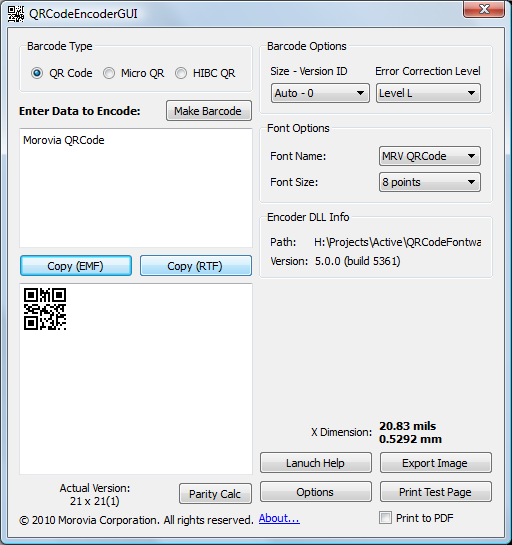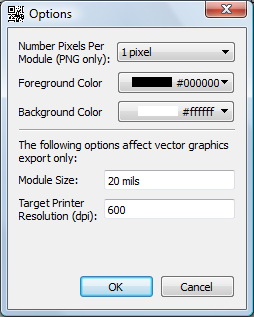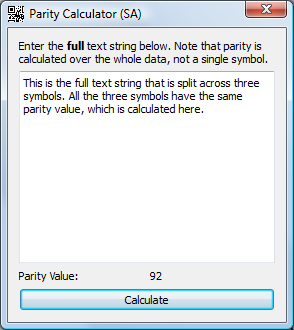Table of Contents
Morovia QRCode Encoder GUI is a GUI program that runs on Windows 2000 and above. It provides a fast way to create QRCode barcodes on the fly. Note that the program requires the fonts as well as the encoder DLL to be present in the system.
- Barcode Type
Choose the type of the barcode to make - QR Code and HIBC QR Code.
- Data to Be Encoded
This is the place to enter the data to be encoded.
- Copy (EMF)
Place the barcode image in the clipboard, so that you can subsequently paste it into another application such as Microsoft Word. The EMF created does not use font, so that you do not need to copy the font file when you view document from another computer.
Note that X dimension in the resulted barcode is determined by the Module Size in the Options dialog, as the EMF format does not use the font.
- Copy (RTF)
Place the barcode string in the clipboard, so that you can subsequently paste them into another application such as Microsoft Word.
QRCode Encoder GUI places both text and RTF formats into the clipboard. In applications that are capable of processing RTF, you will see a barcode immediately after pressing the button. Otherwise, you will see the text string instead. If this is the case, highlight the whole string and format with “MRV QRCode” font.
- Version Info
- Displays the realized version in the QR Code symbol.
- Parity Calc
- Click on this button to pop up the parity calculator, which you can calculate the parity on the source data.
- Launch Help
Launch the HTML Help of this program.
- Options
Pops up the Options dialog where you can specify additional option for exporting barcode images. See Section 3.2, “Export Options” for more information.
- Export Image
Click on this button to export the barcode into standard image formats such as EMF, SVG, EPS and PNG.
- X Dimension
Displays the X-dimension of the barcode. The X dimension is displayed in both mils and mm.
- Encoder DLL Info
This section displays the absolute path and the file version of the encoder DLL. This is useful if you have multiple DLLs in the computer.
- Font Name
Select the font that applies on the barcode string. In this version, the only font selectable is “MRV QRCode”.
- Font Size
Select the font size that applies on the barcode string.
- Size - Version ID
The version of the QR code.
- Error Correction Level
- The error correction level of the barcode. QRCode supports 4 levels - L, M, Q and H.
QRCode Encoder GUI supports four types of images. The images do not contain references to the fonts so that you can move around them without requiring the software to be installed.
EMF. This is the default vector graphics format used on Windows operating system.
PNG. PNG is a bitmap image format widely supported by imaging software. It is the recommended image format for web graphics.
BMP. BMP is the default bitmap format used on Windows platform.
EPS. This format is widely used in graphics design industry. Recommended to use in conjunction with Adobe software such as Adobe Illustrator.
SVG. SVG is an emerging vector graphics format. FireFox 3 supports it out of the box, as well as many drawing programs such as Adobe Illustrator.
You can specify a couple of options applicable in exporting barcode images.
- Number Pixels Per Module
This option applies on raster images only. Specify the number of pixels of a module (the real estate unit of a QRCode barcode).
- Foreground Color
The color of the dark modules, in RGB colorspace. To change the color, press the down arrow key to pop up the color picker.
- Background Color
The color of the white modules, in RGB colorspace. To change the color, press the down arrow key to pop up the color picker.
- Module Size
Apply on Vector image format only. You can specify a nominal size for the module length. You can enter something like "20 mils", or "0.02mm". If the unit of measure is not specified, unit of mils is assumed.
- Target Resolution
Apply on vector image format only. If you export a vector graphic images to a low resolution device such as screen or thermal printer, you should fill this field with the value of the resolution. For screen, use 96. This value makes sure that the length units are properly aligned to the edge of pixels when rasterized.
You can use Parity Calculator to calculate the parity value
of the full data encoded into a group of QRCode symbols using structural
append feature. Note that the parity must remain the same across
all symbols in the group. The input follows Section 2.2.4, “Structural Append (SA)”,
except that the structural append block ~2 is not allowed.



